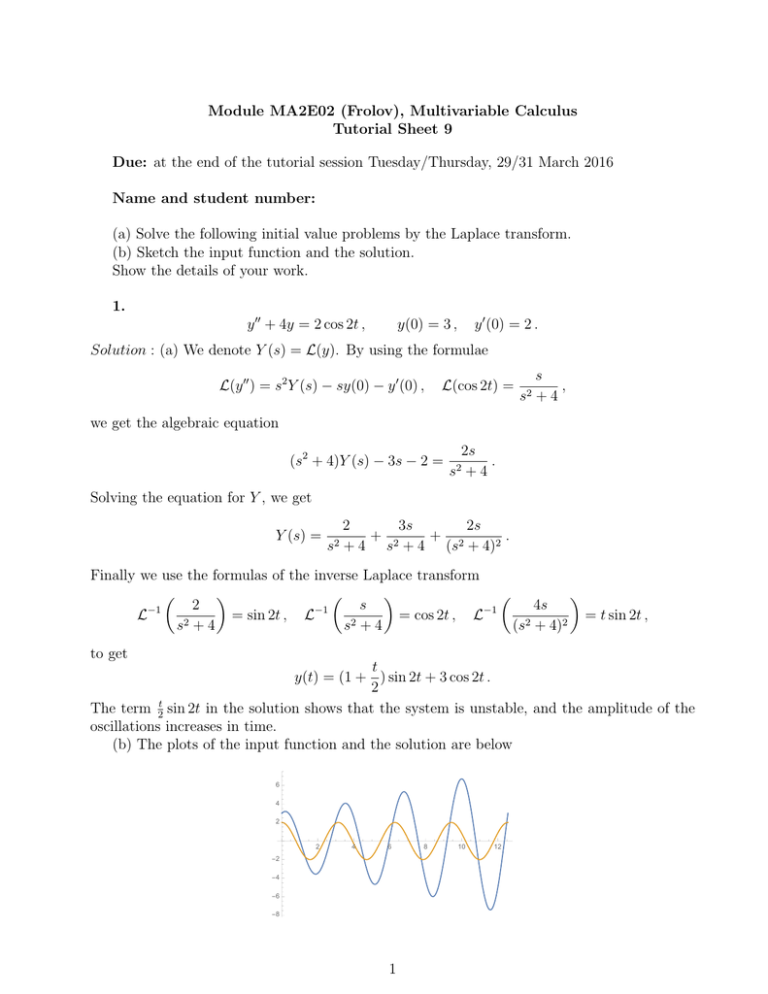Module MA2E02 (Frolov), Multivariable Calculus Tutorial Sheet 9
advertisement

Module MA2E02 (Frolov), Multivariable Calculus Tutorial Sheet 9 Due: at the end of the tutorial session Tuesday/Thursday, 29/31 March 2016 Name and student number: (a) Solve the following initial value problems by the Laplace transform. (b) Sketch the input function and the solution. Show the details of your work. 1. y 00 + 4y = 2 cos 2t , y 0 (0) = 2 . y(0) = 3 , Solution : (a) We denote Y (s) = L(y). By using the formulae L(y 00 ) = s2 Y (s) − sy(0) − y 0 (0) , L(cos 2t) = s , s2 + 4 we get the algebraic equation (s2 + 4)Y (s) − 3s − 2 = 2s . +4 s2 Solving the equation for Y , we get Y (s) = s2 3s 2s 2 + 2 + 2 . + 4 s + 4 (s + 4)2 Finally we use the formulas of the inverse Laplace transform 2 s 4s −1 −1 −1 L = sin 2t , L = cos 2t , L = t sin 2t , s2 + 4 s2 + 4 (s2 + 4)2 to get t y(t) = (1 + ) sin 2t + 3 cos 2t . 2 t The term 2 sin 2t in the solution shows that the system is unstable, and the amplitude of the oscillations increases in time. (b) The plots of the input function and the solution are below 6 4 2 2 4 6 -2 -4 -6 -8 1 8 10 12 2. y 00 + 9y = 13 e−2t , y(0) = 0 , y 0 (0) = 0 . Solution : We denote Y (s) = L(y). By using the formulae L(y 00 ) = s2 Y (s) − sy(0) − y 0 (0) , L(e−2t ) = 1 , s+2 we get the algebraic equation (s2 + 9)Y (s) = 13 . s+2 Solving the equation for Y , we get Y (s) = 13 1 s−2 1 s 2 = − 2 = − 2 + 2 , 2 (s + 2)(s + 9) s+2 s +9 s+2 s +9 s +9 where we used the partial fraction decomposition. Finally we use the formulae of the inverse Laplace transform 3 s 1 −1 −1 −1 L = sin 3t , L = cos 3t , L = e−2t , 2 2 s +9 s +9 s+2 to get 2 sin 3t . 3 (b) The plots of the input function and the solution are below y(t) = e−2t − cos 3t + 3 2 1 1 2 3 4 5 6 -1 Note that the oscillations stabilise very quickly and become harmonic. 3. 00 y + 4y = 4t if 0 < t < 2π , 0 if t > 2π y(0) = 0 , y 0 (0) = 0 . Solution : We denote Y (s) = L(y) and represent the function on the right-hand side of the equation as r(t) = 4t (u(t) − u(t − 2π)) . 2 By using the formulae L(y 00 ) = s2 Y (s)−sy(0)−y 0 (0) , L(f (t−a)u(t−a)) = e−as F (s) ⇒ L(r) = 4 4e−2πs 8πe−2πs , − 2 − s2 s s where we represented r(t) as r(t) = 4t (u(t) − u(t − 2π)) = r(t) = 4tu(t) − 4(t − 2π)u(t − 2π) − 8πu(t − 2π) , we get the algebraic equation (s2 + 4)Y (s) = 4 4e−2πs 8πe−2πs . − − s2 s2 s Solving the equation for Y , we get Y (s) = 4 4e−2πs 8πe−2πs − + . s2 (s2 + 4) s2 (s2 + 4) s(s2 + 4) Then we represent 1 1 4 = 2− 2 , + 4) s s +4 8π 2π 2πs = − 2 . + 4) s s +4 s2 (s2 s(s2 Finally we use the formulae of the inverse Laplace transform 2 s −1 −1 −1 −as L = sin 2t , L = cos 2t , L e F (s) = f (t − a)u(t − a) , s2 + 4 s2 + 4 to get y(t) = t − 1 sin 2t if 0 < t < 2π , 2 and y(t) = t − 1 1 sin 2t − ((t − 2π) − sin 2(t − 2π)) − 2π(1 − cos 2(t − 2π)) if t > 2π . 2 2 Simplifying the expression above, we get t − 21 sin 2t if 0 < t < 2π y(t) = . 2π cos 2t if t > 2π The plots of the input function and the solution are shown below. 3 25 20 15 10 5 5 -5 4 10





